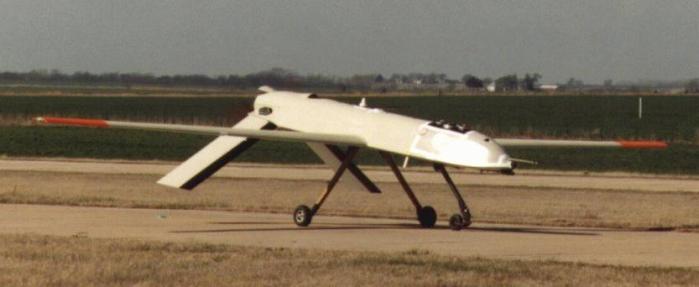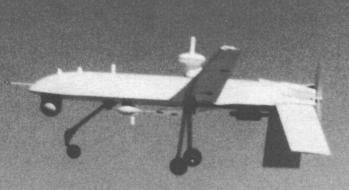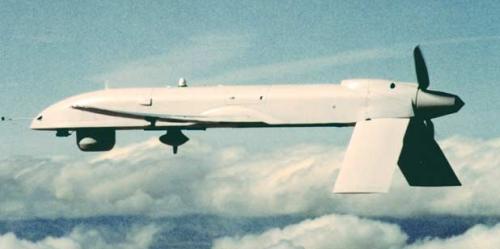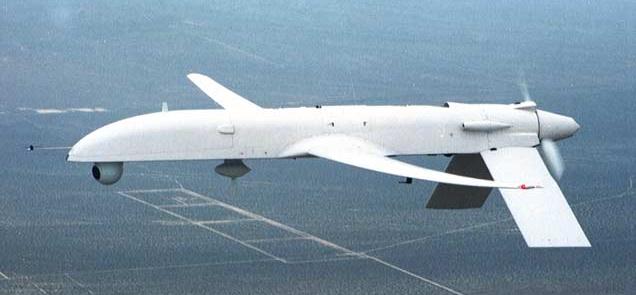General Atomics Gnat
In 1988, Leading Systems Inc. (LSI) began the development of the Gnat-750 UAV as an improved derivative of their Amber vehicle then in advanced development for the U.S. military's JPO (Joint Program Office) for UAVs. The Gnat-750 was intended primarily for export, and the first flight occurred in summer 1989. However, by that time LSI was in serious financial difficulties, and in 1990 all its assets were bought by General Atomics, who then continued to develop the Gnat-750.
The Gnat-750 is essentially a scaled-up and much-refined development of the Amber, and is powered by the same Rotax 582 piston-engine. The major design differences are a new fuselage, and a more conventional low-mounted wing, which replaces the Amber's high pylon-mounted one. The Gnat-750 can also be equipped with a GPS-based navigation system for fully autonomous missions. In July 1992, a Gnat-750 flew continuously for more than 40 hours, and maximum endurance is quoted as 48 hours. The UAV's standard payload is a movable sensor turrent under the nose, which houses a stabilized FLIR (Forward-Looking Infrared) system, a daylight TV and a low-light TV camera. General Atomics also built the Gnat-BT, a much smaller vehicle with the same control system as the Gnat-750. The Gnat-BT was to be used for operator training without risking the bigger operational UAV and its payload.
 |
| Photo: Sandia |
| Gnat-750 |
In 1993 the DOD's Joint Chiefs of Staff presented a very short-term requirement for a surveillance UAV to support UN peacekeeping forces in the civil war in former Yugoslavia. It was quickly decided to use the Gnat-750 and modify it for the intended mission with an off-the-shelf sensor package. This modified variant was also known as Gnat-750-45. Two UAVs were to be bought, but since the system needed to be operational in October 1993, standard military procurement procedures were deemed to be too slow. Therefore, the military Gnat-750-45 was transferred to the CIA. The program was also known as I-MAE (Interim Medium Altitude Endurance), and as "Tier 1" (in a series of DARPA programs for endurance UAVs which also included the "Tier 2" RQ-1 Predator, "Tier 2+" RQ-4 Global Hawk and "Tier 3-" RQ-3 DarkStar).
 |
| Photo: via Jane's |
| Gnat-750-45 (Tier 1) |
Technical and management problems delayed the program, and one air vehicle was lost in late 1993. However, the remaining Gnat-750-45 was ready for use in early 1994, and in February the CIA began operations from a base in Albania. Because the range of the Gnat-750-45's datalink was limited, an RG-8A motor-glider was used as a relay aircraft for the command and control uplink and sensor data downlink. The relay antenna on the UAV was housed in a prominent tear-drop dome atop the fuselage. The Gnat-750-45's tasks included following UN convoys, spotting entrenchments and identifying artillery sites. However, the operations in Albania were cut short because of bad weather and problems with the datalink. The UAV (plus an additional leased one) was refitted with improved SIGINT and thermal imaging sensors, and deployed from Croatia later in 1994 with somewhat better success. Since then, the CIA has acquired additional Gnat-750-45 systems, and the UAVs have reportedly been equipped with a high-resolution SAR (Synthetic Aperture Radar). The latest Gnat-750-45s are also fitted with equipment to serve as datalink relays. It's now possible to fly much longer long-range missions, because the relay's endurance matches that of the data-gathering UAV. The codename LOFTY VIEW has also been associated with the CIA's Gnat-750-45 program.
 |
| Photo: General Atomics |
| I-Gnat |
Around 1997/98, General Atomics began the development of the I-Gnat ("International Gnat"), an enlarged and more capable derivative of the Gnat-750. The I-Gnat uses the fuselage of the RQ-1 Predator, without the latter's bulbous satcom dome at the front. As such, the I-Gnat also has a more powerful engine than the Gnat-750, either the Rotax 912 or the turbocharged Rotax 914. Further improvements include more payload options, increased payload capacity, more versatile mission planning software and provisions to carry weapons and equipment on five external hardpoints (one under fuselage, four under wings). In October 1998, an I-Gnat demonstrated an endurance of 48 hours and a maximum altitude of 9300 m (30500 ft).
 |
| Photo: General Atomics |
| I-Gnat |
In 2003, the U.S. Army procured three I-Gnat ER UAVs to supplement its RQ-5 Hunter and RQ-7 Shadow 200 tactical UAVs. These I-Gnats are equipped to launch the AGM-114 Hellfire and FIM-92 Stinger guided missiles from underwing hardpoints. As of May 2004, two of the UAVs were in use in the ongoing operations in Iraq, but the Army didn't disclose so far whether they are actually flying armed missions.
Another version of the I-Gnat family is the Gnat XP (Extended Performance), which was built for the CIA to replace their older Gnat-750-45s. The Gnat XP was reportedly first deployed in 1998, but eventually the aircraft was replaced by the Predator. The latter's satellite communications system was apparently more practical than the Gnat XP's multi-UAV line-of-sight relay system.
Specifications
Note: Data given by several sources show slight variations. Figures given below may therefore be inaccurate!
Data for Gnat-750, I-Gnat (with Rotax 914 engine):
| Gnat-750 | I-Gnat | |
|---|---|---|
| Length | 5.33 m (17 ft 6 in) | 6.32 m (20 ft 9 in) |
| Wingspan | 10.76 m (35 ft 3.6 in) | 12.86 m (42 ft 2.4 in) |
| Weight | max: 510 kg (1126 lb); empty: 254 kg (560 lb) | max: 700 kg (1550 lb); empty: 385 kg (850 lb) |
| Speed | 259 km/h (161 mph) | 296 km/h (184 mph) |
| Ceiling | 7620 m (25000 ft) | 9140 m (30000 ft) |
| Range | 2780 km (1500 nm) | |
| Endurance | 48 h | |
| Propulsion | Rotax 582 piston engine; 48.5 kW (65 hp) | Rotax 914 piston engine; 78.3 kW (105 hp) |
Main Sources
[1] Curtiss Peebles: "Dark Eagles: A History of Top Secret U.S. Aircraft Programs", Presidio, 1999
[2] Kenneth Munson (ed.): "Jane's Unmanned Aerial Vehicles and Targets, Issue 15", Jane's, 2000
[3] Roxana Tiron: "Army Unmanned Air Vehicles Proliferate
in the Battlefield", National Defense Magazine, May 2004
[4] UAV Forum Website
[5] "Unmanned Aircraft Systems Roadmap, 2005-2030", Office of the Secretary of Defense, August 2005
Back to Directory of U.S. Military Rockets and Missiles, Appendix 4
Last Updated: 1 July 2007